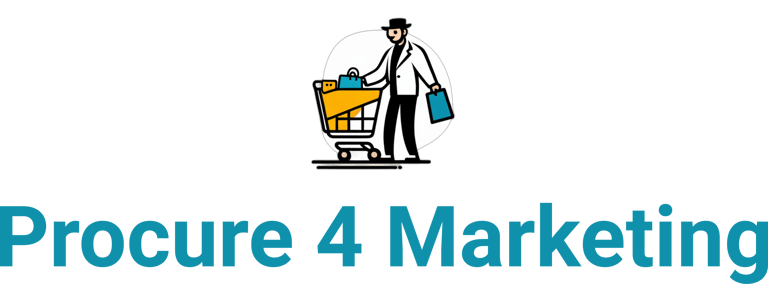Criteria for Evaluating Suppliers and Agencies
Learn how to evaluate suppliers and agencies with this guide to the 5 key criteria: Quality, Cost & Value, Reliability, Value Alignment, and Innovation.
MARKETING PROCUREMENT
The Procure 4 Marketing Team
9/6/20234 min read


Quick Answer: What are the key criteria for evaluating suppliers?
The five key criteria for evaluating any supplier or agency are: 1) Quality of Service/Product, ensuring their deliverables meet your standards; 2) Cost & Overall Value, focusing on the Total Cost of Ownership (TCO), not just the price; 3) Reliability & Stability, confirming they can deliver consistently and are financially sound; 4) Alignment with Company Values, ensuring their ethical and sustainable practices match your own; and 5) Flexibility & Innovation, assessing their ability to adapt and bring new ideas.
How to Evaluate Suppliers and Agencies
Choosing the right partners is one of the most critical decisions in procurement. A great supplier can be a powerful competitive advantage, while a poor one can lead to costly delays and damage your brand. A thorough evaluation process goes beyond just comparing price tags; it's a strategic assessment to find a partner that aligns with your needs for quality, value, and reliability. Here are the five criteria you should use.
The 5 Key Criteria for Supplier Evaluation
1. Quality of Service or Product
This is the most fundamental criterion. A low price is meaningless if the product or service fails to meet your standards.
What to Look For:
Performance & Durability: Does the product function as promised?
Compliance & Certifications: Does the supplier meet required industry standards (e.g., ISO 9001)?
Customer Service & Support: How responsive and helpful is their team?
Reviews & Testimonials: What do their past and current clients say about them?
Real-World Example: You are evaluating two suppliers for a promotional T-shirt. Supplier A is 10% cheaper, but their sample shirt is made of a thin material that shrinks after one wash. Supplier B's shirt is higher quality and more durable. Choosing Supplier B protects your brand's reputation for quality.
2. Cost & Overall Value
While cost is critical, the focus should be on the best value, not just the lowest price. This means evaluating the Total Cost of Ownership (TCO) over the long term.
What to Look For:
Transparent Pricing: Are there hidden fees for setup, maintenance, or support?
Total Cost of Ownership (TCO): What are the long-term costs of using this product or service?
Industry Benchmarks: Is the pricing competitive with the broader market?
Negotiation Flexibility: Are they willing to negotiate on terms and pricing for a long-term partnership?
Real-World Example: You are choosing between two software providers. Vendor A has a lower annual license fee but charges extra for support and training. Vendor B's license is more expensive, but it includes full support and training. Vendor B offers a lower TCO and better overall value.
3. Reliability & Stability
A great supplier delivers what they promise, when they promise it, and is a financially stable business that you can count on for the long term.
What to Look For:
Track Record: What is their history of on-time delivery?
Financial Health: Are they a financially stable company? (You can check credit ratings for major suppliers).
Risk Management Plans: Do they have contingency plans for potential disruptions?
References: What do their long-term clients say about their consistency?
Real-World Example: You are selecting an event management agency for your most important conference of the year. Agency A has a flashy creative pitch but mixed reviews on execution. Agency B has a strong, proven track record of flawless execution and glowing client references. Agency B is the more reliable choice.
4. Alignment with Company Values
In today's market, your suppliers are a reflection of your own brand. It's crucial to partner with companies that share your commitment to ethical, social, and environmental standards.
What to Look For:
Sustainability Practices: Do they use eco-friendly materials or processes?
Ethical Sourcing: Do they have a clear policy on fair labor and human rights?
Cultural Fit: Does their way of working feel compatible with your company's culture?
Real-World Example: Your company has a strong public commitment to sustainability. When choosing a printing supplier, you select a vendor that is certified by the Forest Stewardship Council (FSC) and uses soy-based inks, even if they are slightly more expensive, because it aligns with your brand's core values.
5. Flexibility & Innovation
The best partners don't just take orders; they adapt to your changing needs and bring new ideas to the table.
What to Look For:
Adaptability: How do they handle unexpected changes or urgent requests?
Proactive Problem-Solving: Do they bring you solutions, or just problems?
Commitment to Innovation: Do they invest in new technologies and processes to improve their own offerings?
Real-World Example: You work with a digital marketing agency that notices your campaigns are getting great results on a new social media platform. They proactively pitch a plan to reallocate some of your budget to this new channel to capitalize on the trend. This demonstrates innovation and a commitment to your success.
Frequently Asked Questions (FAQ)
Q1: What is a "supplier scorecard"?
A supplier scorecard is a tool used to objectively evaluate and compare suppliers. You list your key criteria (like quality, cost, reliability) and assign a weight to each based on its importance. You then score each supplier on a scale (e.g., 1-5) for each criterion. This gives you a final, data-driven score to help you make an unbiased decision.
Q2: What is a "pilot test"?
A pilot test is a small-scale, trial run of a vendor's product or service before you sign a major contract. For example, you might hire a new creative agency for one small project to "pilot" their work and see how you collaborate before awarding them a larger, long-term contract.
Q3: How many suppliers should I evaluate for a single purchase?
A common best practice is the "rule of three." For any significant purchase, you should aim to get at least three competitive bids or proposals. This provides a good benchmark for cost and capabilities without making the evaluation process overly complex.

